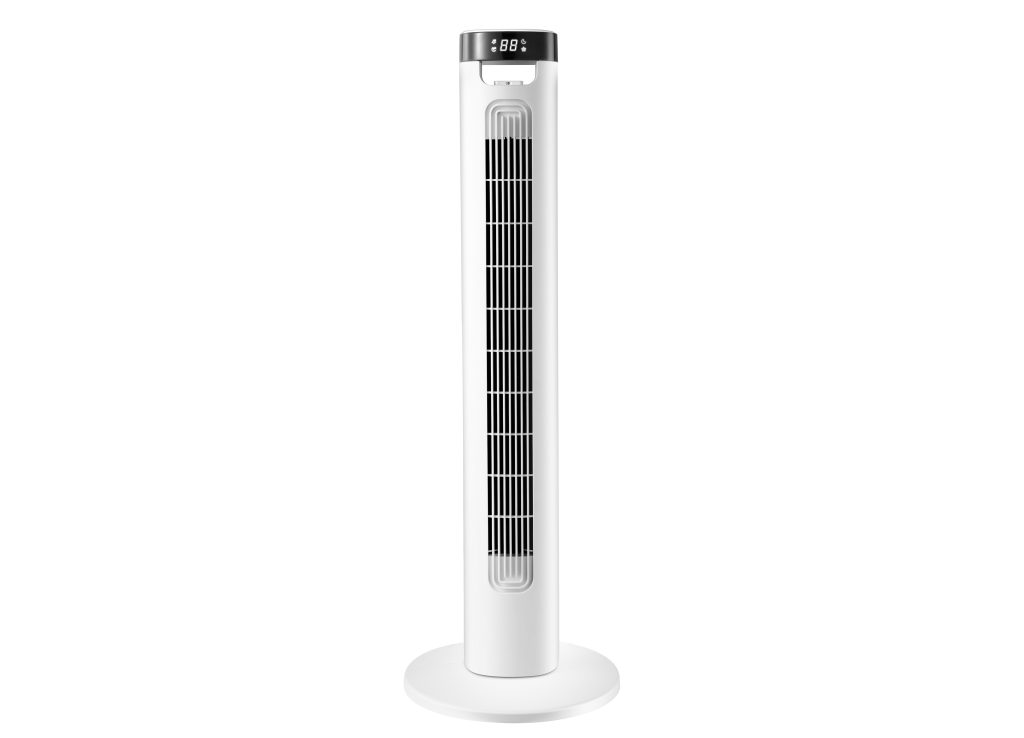Electric Fan vs. Bladeless Fan: A Comprehensive Comparison of Motor Technologies and Airflow Efficiency
Introduction
When faced with the decision of selecting between a traditional electric fan and a bladeless fan, there are several important factors to consider. These include motor technology, airflow efficiency, noise levels, energy consumption, and overall durability. While conventional electric fans utilize rotating blades powered by brushed or brushless DC (BLDC) motors, bladeless fans employ turbine-driven air multipliers that generate smooth, continuous airflow.

This article will offer an in-depth analysis, breaking down the key differences in:
- Motor technologies (BLDC vs. turbine-driven induction systems)
- Airflow efficiency (CFM, air velocity, and distribution)
- Noise levels and acoustic performance
- Energy consumption and heat management
- Cost-effectiveness and value for both residential and commercial use
By the end of this comparison, you’ll have a clearer understanding of which fan type best suits your needs based on performance, efficiency, and overall functionality.
1. Motor Technologies: Brushless DC vs. Turbine-Driven Systems
Traditional Electric Fans: BLDC Motors and Mechanical Blades
In most modern electric fans, brushless DC (BLDC) motors are used due to their high efficiency and reliability. These motors are capable of operating at an impressive efficiency of up to 90%. Unlike traditional brushed motors, BLDC motors experience less friction and wear, resulting in a longer lifespan for the fan.
The motor drives a set of 3 to 5 aerodynamically designed blades that are typically made of durable materials such as ABS plastic or aluminum. These blades work together to push air in a forward direction, providing the desired cooling effect.
Advantages of Traditional Fans with BLDC Motors:
- Precise speed control via Pulse Width Modulation (PWM)
- Energy-efficient operation with low power consumption (typically between 15W and 50W for residential models)
- Minimal electromagnetic interference due to the nature of the BLDC motor
Bladeless Fans: Turbine Motors and Air Multiplier Technology
Bladeless fans, made famous by companies like Dyson, feature a unique motor system that uses a high-speed turbine motor. The turbine motor, often based on BLDC technology, is housed within the base of the fan. It draws air into the unit and expels it through a narrow slit in the fan’s casing. This method uses the Coandă effect to entrain surrounding air, amplifying the airflow without the need for rotating blades.
Advantages of Bladeless Fans:
- No exposed blades, making them safer to operate and easier to clean
- Smooth, laminar airflow, which is less turbulent and more comfortable
- Variable speed control without the resistance typically found in mechanical blades
Technical Takeaway:
While both traditional and bladeless fans may use BLDC motors, the key difference lies in how the air is moved. Traditional fans rely on mechanical blades, while bladeless fans use advanced fluid dynamics to achieve smoother and quieter airflow.
2. Airflow Efficiency: Comparing CFM, Velocity, and Distribution
Measuring Airflow: CFM and Air Velocity
When evaluating the efficiency of a fan, airflow is usually measured in terms of CFM (Cubic Feet per Minute), which indicates the volume of air moved by the fan. Another key factor is air velocity, which is the speed at which the air is traveling, usually measured in miles per hour (mph) or meters per second (m/s).
- Traditional Electric Fans: These fans are designed to produce high CFM, delivering a direct, powerful stream of air. For example, a typical 20-inch pedestal fan might achieve CFM ratings between 4,000 and 5,000, making it excellent for spot cooling in large or open spaces. However, the airflow tends to be turbulent, leading to uneven distribution and potential discomfort from wind buffeting.
- Bladeless Fans: Bladeless fans, on the other hand, focus on achieving a more consistent and even airflow. While a high-end bladeless fan might produce a lower CFM, typically ranging from 1,500 to 2,500, the distribution of air is more uniform thanks to the Coandă effect. This results in less turbulence and a more comfortable cooling experience, especially in enclosed spaces like offices or bedrooms.
Airflow Patterns: Turbulence vs. Laminar Flow
- Traditional Fans: Due to their rotating blades, these fans generate turbulent airflow, leading to vortex shedding (air pockets that swirl and disrupt airflow). This turbulence contributes to the characteristic noise that traditional fans are known for.
- Bladeless Fans: With their smooth, uninterrupted airflow, bladeless fans create laminar flow, which is much more stable and quieter. This airflow pattern not only enhances comfort but also minimizes the sensation of drafts or wind chop.
Technical Takeaway:
If you need maximum airflow for large or industrial spaces, traditional fans are the better option. However, if you prefer quieter, more even airflow for smaller rooms or living spaces, bladeless fans excel in providing this type of comfort.
3. Noise Levels and Acoustic Performance
Blade Turbulence in Traditional Fans
The primary source of noise in traditional fans comes from the interaction between the blades and the air. As the blades rotate at high speeds, they create aerodynamic noise, especially at the tips of the blades where airflow is disrupted. In addition, motor hum and vibrations from worn-out bearings contribute to the overall noise level.
High-quality BLDC fans typically produce noise levels ranging from 35 to 50 decibels (dB), which is similar to the sound of a quiet conversation. However, cheaper models may generate noise levels exceeding 60 dB, which can be bothersome in noise-sensitive environments.
Bladeless Fans: Noise Reduction and Jet Entrainment
Since bladeless fans do not have rotating blades, they significantly reduce vortex-induced noise. The sound produced by these fans primarily comes from the turbine motor and the air rushing through the narrow aperture. High-end bladeless fans often use acoustic enclosures to mitigate turbine whine and sophisticated boundary layer control to reduce noise from the rushing air.
The noise levels in bladeless fans typically range from 25 to 40 dB, making them an ideal choice for bedrooms, offices, or any other space where quiet operation is crucial.
Technical Takeaway:
For silent operation, bladeless fans are the clear winner. They produce less noise and provide a more serene environment, especially when compared to traditional fans, which tend to be louder and more disruptive.
4. Energy Consumption and Thermal Management
Power Efficiency: Comparing BLDC and Turbine-Driven Systems
Energy consumption is another important factor to consider. Both traditional electric fans and bladeless fans use BLDC motors, which are inherently energy-efficient.
- Traditional Fans: These typically consume between 15W and 50W, depending on the model’s size and power requirements.
- Bladeless Fans: Bladeless fans require more power, typically consuming between 30W and 60W. This higher power consumption is necessary due to the more complex turbine motor system and the increased pressure needed to generate airflow.
However, bladeless fans tend to be more efficient at distributing air, meaning that on lower speed settings, they can achieve similar comfort levels with less power consumption.
Thermal Management: Cooling the Motor
Traditional fans rely on open-air cooling, aided by the airflow generated by the blades themselves. In contrast, bladeless fans require additional internal heat sinks and ventilation channels to cool the turbine motor. This is because the motor is enclosed within the base of the fan, and efficient heat dissipation is necessary to prevent overheating.
Technical Takeaway:
Both fan types are energy-efficient, but bladeless fans tend to use slightly more power due to the increased energy demands of their turbine motors. However, they offer better airflow control and can provide similar comfort at lower speeds.
5. Cost vs. Performance: Which Fan Type Offers Better Value?
Upfront Costs and Long-Term ROI
- Traditional Electric Fans: Typically priced between $20 and $150, traditional fans are much more affordable upfront. They also tend to have a longer lifespan, as the mechanical components are simpler and less prone to failure. Additionally, maintenance costs are lower because there are fewer intricate parts.
- Bladeless Fans: Bladeless fans can be more expensive, with prices ranging from $100 to $600. The higher cost is due to the advanced engineering and turbine-driven technology. However, the increased safety, quieter operation, and superior airflow quality may justify the premium for some users.
Maintenance and Durability
Traditional fans require occasional cleaning of the blades and lubrication of the bearings. Over time, the mechanical wear on the blades and motor may necessitate repairs or replacements.
Bladeless fans, with fewer moving parts, are easier to maintain in terms of cleaning. However, their internal components are more complex, and repairs can be more expensive and challenging to carry out.
Final Verdict:
- For budget-conscious buyers, traditional fans provide a better value, offering high airflow at a lower cost.
- For those who prioritize quieter operation, advanced safety features, and superior airflow quality, bladeless fans are worth the higher initial investment.
Conclusion: Which Fan is Right for You?
The choice between a traditional electric fan and a bladeless fan ultimately depends on your specific needs and preferences.
- Choose a traditional electric fan if:
- You require maximum airflow at an affordable price.
- Noise is not a significant concern, such as in workshops, garages, or industrial settings.
- You prefer simple, low-cost maintenance.
- Choose a bladeless fan if:
- You value quiet, smooth airflow, ideal for bedrooms, offices, or other quiet spaces.
- Safety and aesthetics are important to you (no exposed blades).
- You’re willing to invest in cutting-edge technology for superior comfort.
Both technologies have advanced considerably in recent years, with BLDC motors at the forefront of energy efficiency. For engineers and procurement specialists, the decision ultimately comes down to whether raw airflow power or refined, quiet airflow is more important for your specific use case.
Final Thought:
For most residential settings, bladeless fans provide a higher level of comfort and convenience. However, for large-scale industrial or commercial cooling, traditional fans offer more powerful airflow for a lower cost.
